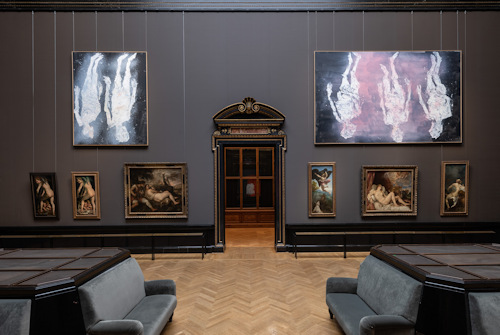Think of the Kunsthistorisches Museum (KHM) as a giant chest of artistic treasures, all tied up in beautiful architectural gift wrap.
Numerous world-class works of art live inside. You probably assume we’re talking paintings. But while the picture gallery is indeed mightily impressive, it’s just one of several important collections.
- Outstanding selection of historical art
- Best areas: the paintings & Kunstkammer
- Book your KHM tickets* online
- Selected special exhibitions:
- Holbein, Burgkmair & Dürer (until Jun 30, 2024)
- See also:
Inside the Museum
(The museum looks gorgeous at night)
The Kunsthistorisches Museum includes several self-contained sections addressing different kinds of art or eras. The best areas depend on your interests, but I particularly recommend:
- The galleries of paintings, featuring numerous works by a who’s who of western European painting pre-1800. Look, particularly, for the world-leading Bruegel collection
- The Kunstkammer “chamber of wonders”, full of astonishing artifacts from the past…from magnificent backgammon sets to salt cellars worth the GDP of a small country (possibly)
Other areas are:
- The Egyptian Collection, containing all you might expect in your A-Z of motifs from Ancient Egypt: sarcophagi, canopic jars, scrolls, statues, and more
- The Greek and Roman Antiquities, where the clever positioning and gorgeous lighting of the displays might be considered art in their own right
- The Coin Collection, which also includes a remarkable series of mini-portrait paintings of historical personalities
- The Vermeyen Cartoons, documenting the early 16th-century Tunis campaign of Emperor Charles V
Special exhibitions

(Baselitz. Naked Masters. Exhibition view © KHM-Museumsverband. A 2023 dialogue between the traditional classics and contemporary art)
The Kunsthistorisches Museum hosts a major year-end event around the theme of old masters (like Caravaggio, Titian, or Pieter Bruegel the Elder). But you’ll come across various special exhibitions throughout the year, including those covering more contemporary art.
The big year-end exhibition in 2023, for example, was on monumental Renaissance tapestries and the role played by Raphael in their artistic evolution. Expect a Rembrandt-flavoured exhibition at the end of 2024.
Oh, and the building leaves a remarkable impression in its own right, particularly the dome and the staircase (with its Klimt interior decoration).
So possibly more art than you can eat in one sitting, especially if you want time to digest what you’re viewing.
Tickets & visitor tips
Note that almost all special exhibitions are included within any entrance ticket for or from the KHM. Selected exhibitions do require their own timeslot ticket (available direct from the museum), as is the case for the Rembrandt – Hoogstraten exhibition scheduled for the end of 2024.
(Booking service provided by Tiqets.com*, who I am an affiliate of)
A few tips for your visit:
- At times, particularly during significant exhibitions, the museum ticket counters move to containers on the square outside the main entrance.
- Once through the ticket check, look up (trust me).
As mentioned, the museum building itself is rather impressive. So, actually, you should look up, down, and around everywhere as you view the collections. The entrance hall and dome quite take your breath away.
- After you get in, go left to put away coats and bags in the cloakroom, which also has coin-operated lockers. Go ahead for audioguides or right for the shop and guidebooks.
- The Kunstkammer contains a lot of accessible information via tablets and the picture galleries have plenty of English, too. Other areas have more and more English each time I visit, but you might want the English audioguide or a book.
- Alternatively, use the KHM Stories app for themed English-language tours of the collection (available for free from the iPhone and Android app stores).
- I took several hours just in the Kunstkammer, which is but one section of the building. So either you set aside plenty of time or you simply browse through the Kunsthistorisches Museum highlights (an info leaflet should identify these for you).
- The cafe/restaurant makes a remarkably grand place to drink a coffee.
- If you’re there for the paintings by old masters, consider also a couple of other destinations afterwards.
- The picture gallery of the Academy of Fine Arts Vienna, which includes Hieronymus Bosch’s The Last Judgment
- Check the current special exhibitions at the Albertina, which may also feature older works
Finally, the Kunsthistorisches Museum feels like a place for hushed voices: a cathedral of art that’s not unwelcoming, but don’t expect much in the way of dumbed-down infotainment or edutainment. I have yet to see any cartoon figures encouraging us to discover the joys of Italian Baroque paintings.
Having said that, the museum has taken a more engaging narrative approach to recent exhibitions, making them easy to enjoy even without any previous knowledge.
How to get to the museum
The Kunsthistorisches Museum sits opposite its twin – the Natural History Museum – on the square named in honour of Empress Maria Theresa.
The two buildings look almost identical, both completed in the late 1800s as part of Emperor Franz Joseph’s expansive plans for the Ring.
If you get the museums mixed up, you may find yourself standing in front of a stuffed wildebeest debating how the artist uses the piece to question the true nature of human existence. But it’s actually just a stuffed wildebeest.
The well-worn walking routes around Vienna’s centre likely take you past. If traveling by public transport, then…
Subway: U2 or U3 to Volkstheater and a short walk
Tram: 1, D, 71, 46, 49 or 2 to Ring/Volkstheater or the 1, 2, 71 and D to Burgring
Bus: 48A to Ring/Volkstheater or the 57A to Burgring
Address: Burgring 7, 1010 Vienna | Website

